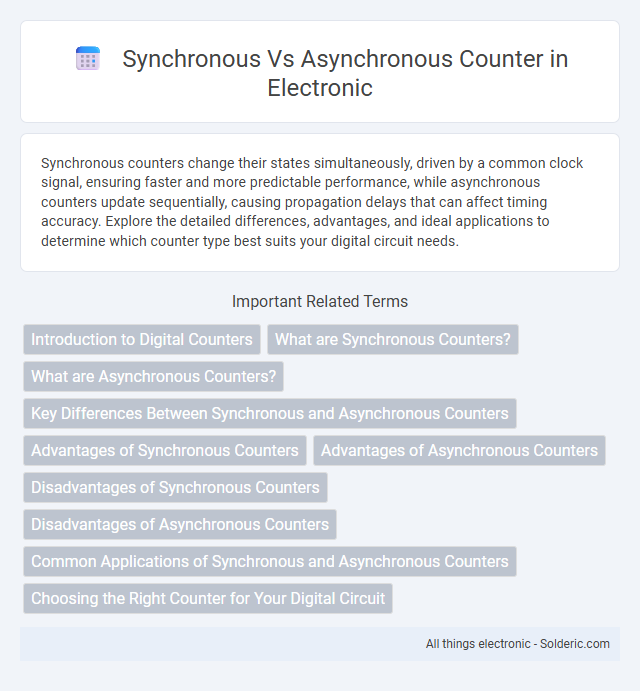Synchronous counters change their states simultaneously, driven by a common clock signal, ensuring faster and more predictable performance, while asynchronous counters update sequentially, causing propagation delays that can affect timing accuracy. Explore the detailed differences, advantages, and ideal applications to determine which counter type best suits your digital circuit needs.
Comparison Table
| Feature | Synchronous Counter | Asynchronous Counter |
|---|---|---|
| Clock Signal | Single, common clock source for all flip-flops | Clock input cascades from one flip-flop to the next |
| Speed | Faster operation due to simultaneous clocking | Slower, clock propagation delay accumulates |
| Complexity | More complex circuit design | Simpler, fewer components |
| Propagation Delay | Minimal, depends on flip-flop setup time | High, cumulative delay through flip-flops |
| Size | Larger due to additional gating and control logic | Smaller and compact |
| Reliability | More reliable with better performance in high speed | Less reliable at higher speeds due to delays |
| Application | Used in high-speed digital circuits and processors | Used in simple, low-speed counting applications |
Introduction to Digital Counters
Digital counters function as sequential logic circuits that store and display the number of pulses or events in binary form. Synchronous counters update all flip-flops simultaneously with a shared clock signal, ensuring faster operation and better timing control. Asynchronous counters trigger flip-flops sequentially via the output of the preceding stage, resulting in slower speeds but simpler designs.
What are Synchronous Counters?
Synchronous counters are digital counting circuits where all flip-flops are triggered simultaneously by a common clock signal, ensuring coordinated state transitions. This simultaneous clocking reduces propagation delay compared to asynchronous counters, enhancing speed and performance in counting applications. They are widely used in digital devices requiring precise timing, such as frequency dividers and digital clocks.
What are Asynchronous Counters?
Asynchronous counters, also known as ripple counters, are digital circuits where flip-flops change state at different times, triggered by the output of the previous flip-flop rather than a common clock signal. These counters are simpler and require fewer components, but they suffer from propagation delay, causing slower response times in high-speed applications. Your choice between asynchronous and synchronous counters depends on the required speed and complexity of your digital counting system.
Key Differences Between Synchronous and Asynchronous Counters
Synchronous counters have all their flip-flops triggered simultaneously by a common clock signal, ensuring precise timing and faster operation compared to asynchronous counters, where flip-flops are triggered sequentially by the output of the preceding stage. Asynchronous counters tend to experience propagation delays that accumulate through each stage, potentially causing timing errors in high-speed applications. Your choice between synchronous and asynchronous counters depends on the required speed, complexity, and timing accuracy of the digital circuit.
Advantages of Synchronous Counters
Synchronous counters offer faster operation because all flip-flops receive the clock signal simultaneously, eliminating ripple delay found in asynchronous counters. This parallel clocking enhances timing accuracy and reliability in digital circuits, making synchronous counters ideal for high-speed applications. Your designs benefit from simplified timing analysis and improved performance due to the synchronized state changes.
Advantages of Asynchronous Counters
Asynchronous counters require fewer hardware components, leading to simpler circuit designs and reduced power consumption compared to synchronous counters. Their ease of implementation and lower cost make them suitable for applications with low-speed requirements. These counters also generate less electromagnetic interference due to their sequential switching nature.
Disadvantages of Synchronous Counters
Synchronous counters suffer from increased complexity and higher power consumption due to the need for multiple flip-flops triggered simultaneously. Propagation delay can become significant as the number of bits increases, limiting the maximum operating speed. Your design may also face scalability challenges and difficulty in troubleshooting because all flip-flops switch in unison, creating more potential timing issues.
Disadvantages of Asynchronous Counters
Asynchronous counters suffer from uneven propagation delays due to the ripple effect, causing timing errors and limited maximum operating speed. Their output changes do not occur simultaneously, leading to glitches and unstable states during switching. These disadvantages reduce the reliability and performance of asynchronous counters in high-speed or precision applications.
Common Applications of Synchronous and Asynchronous Counters
Synchronous counters are widely used in digital systems requiring precise timing, such as frequency dividers, digital clocks, and event counters, due to their simultaneous state changes driven by a common clock. Asynchronous counters find common applications in simple ripple counters and low-speed event counting where ease of design and low power consumption are important. Both types serve roles in digital electronics, with synchronous counters preferred for higher speed and accuracy, while asynchronous counters are favored for simpler, cost-effective designs.
Choosing the Right Counter for Your Digital Circuit
Selecting the right counter for your digital circuit hinges on the specific timing and speed requirements; synchronous counters offer simultaneous state changes triggered by a common clock, ensuring faster and more reliable performance in high-speed applications. Asynchronous counters, with their ripple effect where each flip-flop is triggered by the previous one, are simpler and consume less power, making them suitable for low-frequency or less complex designs. Understanding the trade-offs in propagation delay and circuit complexity is essential to optimize the overall efficiency and accuracy of your digital system.
synchronous vs asynchronous counter Infographic

 solderic.com
solderic.com